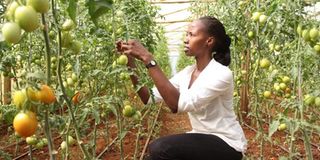Here’s how to curb new tomato pest

Patricia Lagat, tends to a tomato crop in one of the greenhouses at their farm in Cheplaskei, Uasin Gishu County on April 04, 2014. PHOTO | JARED NYATAYA
What you need to know:
- The moth is characterised by a high reproduction potential where one female may lay up to 300 eggs that become destructive about eight days later and feed for up to 10 days.
- Infested plants or plant parts should be removed, especially at the beginning of cultivation, and residues should be disposed of carefully, ensuring that they are stored in sealed containers until they are sent to a waste management facility.
A new insect has hit tomato farmers in Kenya’s six counties.
The pest, commonly called leaf miner (Tuta absoluta), has ravaged several acres of crops in Isiolo, Meru, Embu, Garissa, Marsabit and Wajir counties, with yield losses ranging from 50 to 100 per cent, particularly in areas with low rainfall.
Tuta absoluta is a newcomer in the country and is believed to have arrive from Ethiopia, where huge losses have been reported since last year. The pest has caused a major scare among farmers as they record huge losses.
In 2004, Tuta absoluta (moth) was added to the European and Mediterranean Plant Protection Organisation action list of pests recommended for regulation. In Spain, in the first year of introduction, pesticides were applied 15 times per season with management costs going up by 450 Euros (Sh53,100) per hectare.
The moth is characterised by a high reproduction potential where one female may lay up to 300 eggs that become destructive about eight days later and feed for up to 10 days.
The larva feeds on all plant parts but mainly buds, tender new leaflets, flowers, and green and ripened fruits of tomato as well as potato leaves and tubers.
Conspicuous irregular mines and galleries as well as dark frass make infestations easy to spot. Fruits can be attacked soon after they have been formed, and the galleries made by the larvae can be colonised by pathogens that cause fruit rot.
Treatment can include any combination of the following options. Sanitation and other cultural control methods and application of insecticides mainly pyrethroid pesticides.
In greenhouses, installing double self-closing doors and covering windows and other openings with 1.6 mm (or smaller) insect mesh can prevent entry or exit of adult Tuta absoluta.
Pots, carts and greenhouse tools should be inspected and thoroughly cleaned before moving them to other areas. Farmers should routinely examine the crops’ leaves and stems for evidence of eggs, mines, larvae, frass, and other damage.
Infested plants or plant parts should be removed, especially at the beginning of cultivation, and residues should be disposed of carefully, ensuring that they are stored in sealed containers until they are sent to a waste management facility.
Workers should check their clothing before moving to other greenhouses for the presence of eggs, larvae, and resting adults of Tuta absoluta.
In field grown tomatoes, destruction and incorporation of crop residues after harvest effectively interrupts the life cycle of Tuta absoluta by killing the immature stages present in the plant material. Mechanical harvesting and tilling equipment should be cleaned using high pressure washing or steam after use in infested fields.
Clean and inspect all harvesting containers, field boxes and carts before moving them to other areas. Solanaceous weeds in the vicinity of infested areas should be removed and destroyed to prevent build-up of a potential population reservoir. If at any time during the growing cycle the pest is detected, remove and securely destroy it by ploughing or burning the whole plot to interrupt its pest life cycle.
The wild solanaceous plants to be destroyed include black nightshade (Solanum nigrum), silver nightshade (Solanum elaeagnifolium) and jimson weed (Datura stramonium).
Cultural control methods include reducing Tuta absoluta populations in greenhouse. In this regard, soil solarisation at five weeks eliminates pupae that remain on the ground.
Prof Paul Kimurto, John Nganga and Lilian Jeptanui, Crop Protection Crop Science Department, Egerton University. ([email protected])




